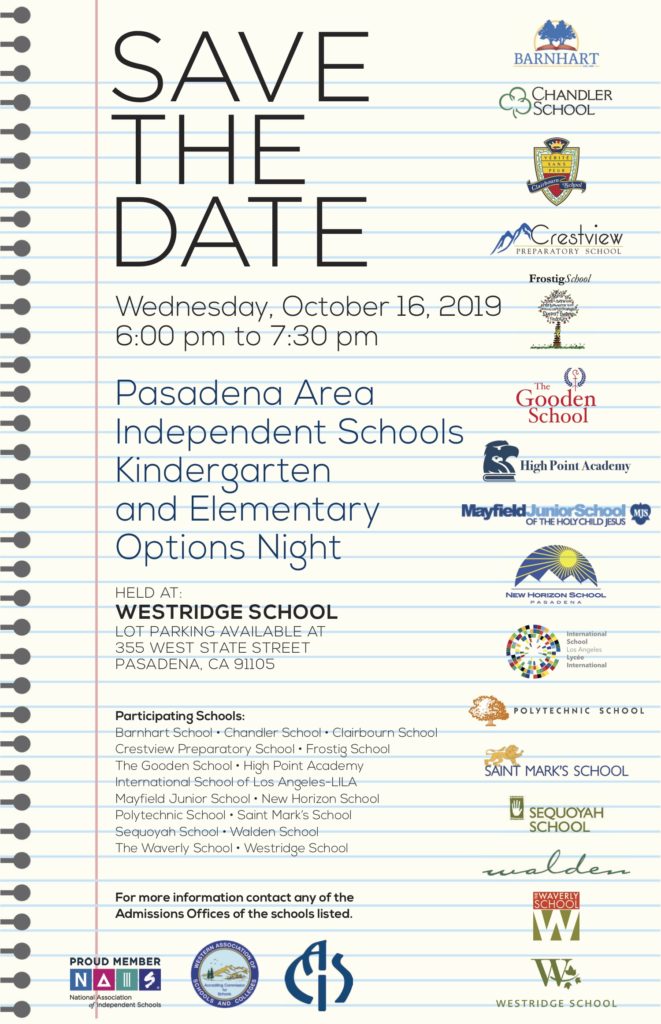
Stay up to date on the latest L.A. private schools news and events! Follow Beyond The Brochure on Facebook. Buy the book on Amazon.

Stay up to date on the latest L.A. private schools news and events! Follow Beyond The Brochure on Facebook. Buy the book on Amazon.

Applying to Private School: All Those Tours & Schools Visits Feel Like a Full-Time Job! Four tips on how to manage your schedule for open houses, tours & other events.
You’re applying to private school. It’s exciting – so many educational roads to take and enriching adventures ahead! And then you start exploring the school websites and signing up for open houses, and tours, and interviews, and community coffee meetings, and homecoming games, and on and on . . . Before you know it, your school visit schedule is busier than your work schedule. It’s enough to overwhelm even the most organized parents!
But it doesn’t need to be this way. You can alleviate this stress with a little insight and prioritization. Some events are mandatory, some are optional, and some you can skip. The four tips below can help you weed through the morass of admissions season scheduling.
1. What you need to attend
2. Maybe or Nice to attend, especially if it’s a school you love
3. No or What you can skip
4. Important things to keep in mind
Remove the Pressure & Enjoy the Process
The admissions process, despite the stress, actually can be informative. It’s a great time to learn more about your child and family, and to explore amazing schools and educational opportunities. When you can manage your schedule – by prioritizing events and not feeling pressure or guilt to attend every single offering – the process becomes easier and more enjoyable. And always remember: admissions is not about a value judgement or assessing the worth of your child; rather, it’s about finding the right fit and going to an environment where your child, and family, will thrive.
Priya and Sanjay Nambiar run Nambiar Advising, a consulting practice that shepherds families through the private school admissions process, from helping clients find the best-fit schools for children to application support, essay editing, interview preparation, and more. Priya has spent more than 20 years in education and was the Associate Director of Admissions at the Brentwood School in Los Angeles. She earned a B.A. in Education from Brown University and an M.Ed. from Harvard University. Sanjay is an entrepreneur and professional writer who has written several award-winning children’s books. He earned a B.A. in Economics and Neurobiology from U.C. Berkeley and an M.B.A. from UCLA. To learn more, please visit www.nambiaradvising.com.
Stay up to date on the latest L.A. private schools news and events! Follow Beyond The Brochure on Facebook. Buy the book on Amazon.


Q: How would you describe the educational philosophy of The Gooden School? It seems like a great blend of traditional elements like uniforms and progressive ideals such as the use of restorative justice for student discipline.
A: At The Gooden School, we meet all children where they are, and we work with them to discover and enhance their gifts. The academic classes are experiential and project-based, and students are encouraged to make connections across grade levels and across the curriculum. Students become problem solvers, advocates for themselves and others, and performers. They use skills gained in academic classes and in sports, music, art, languages, electives, and STEAM to work collaboratively. All of this is reflective of the school motto, “Respect for Self, Respect for Others, and Respect for the World.”

Q: The Gooden School is small, with one class per grade for grades K-8. What are some of the benefits of a small school for students, parents,and staff? How does the school size contribute to the sense of community?
A: Every child (and family) is known and seen by all faculty and staff on campus. This means that students who may be naturally reserved have a voice, that when students are struggling adults can respond quickly, and students are responsible for their own actions. It also means that students participate in everything they want to, and even some activities they may be reluctant to try. All students participate in drama productions, create art and music, participate on teams (whether in P.E., after-school sports, or even as part of debate). The small size means that all teachers really can differentiate within the classroom. There are students who take different languages, or advanced math programs, or students who need one-on-one assistance in some areas. Because of our size, we can provide for these students. As a small community, volunteer participation is a necessity, which allows our families to partner with us, offering them an opportunity to play an integral role in their child’s educational growth.
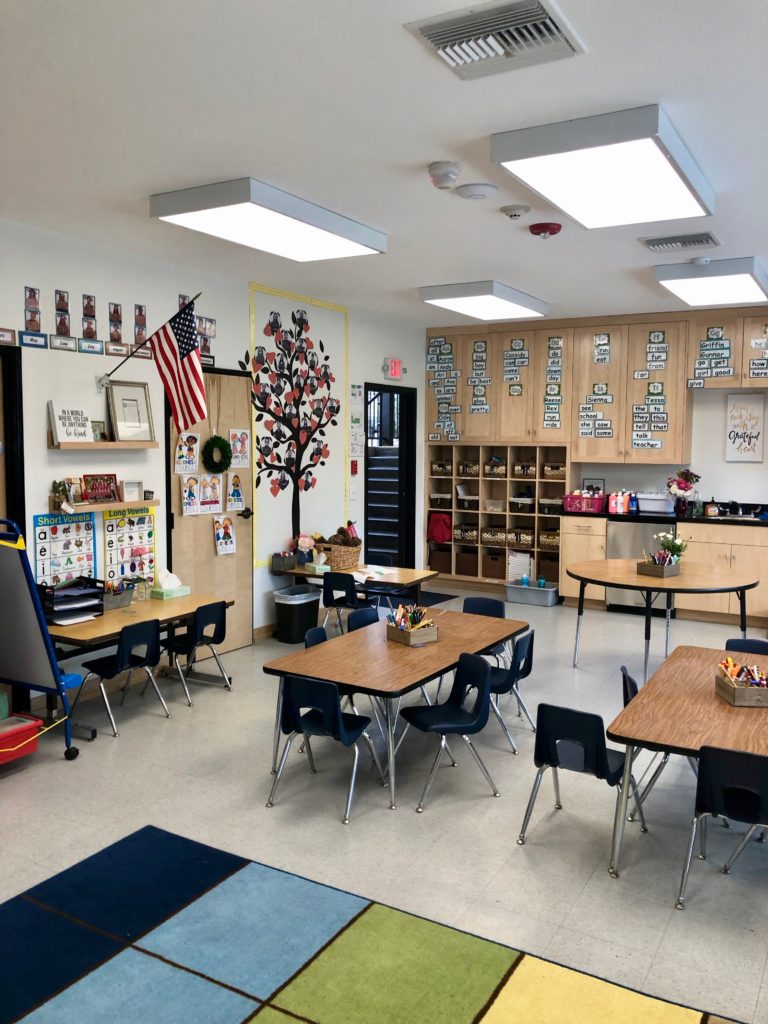
Q: The Gooden School’s STEAM (Science, Technology, Engineering, and Math) program gives students the opportunity to work on real-world projects like helping farmers after a monsoon in Indonesia or getting power to off-the-grid parts of Africa. Why is it important for STEAM to be applied to actual problems across the globe?
A: Global connectedness is essential in today’s classrooms. With the technology available – virtual field trips, connecting with students in other countries – and with the school’s mission that students be engaged with all communities in which they live, it is necessary for them to interact not only with their families and friends and local communities, but also with the world. The application of the collaborative, problem-solving skills students learn is essential to becoming a global citizen. Whether it is working on solutions to environmental issues, or how to communicate with our sister school in Haiti, students learn that the more diverse the experiences and opinions are within the group, the more likely it is that solutions to problems will be found.
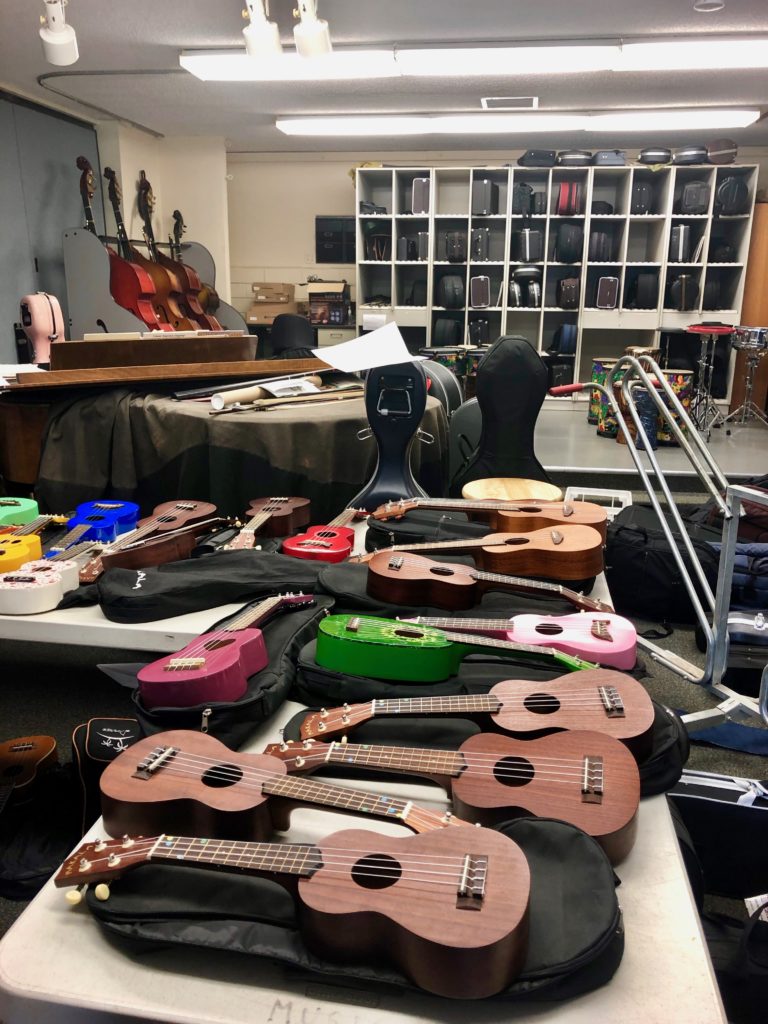
Q: Gooden is an independent Episcopal school and the community attends chapel twice a week. Can you talk about how all faiths are welcome at your Episcopal school?
A: Episcopal schools have been established not solely as communities for Christians, like a parish church, but as ecumenical and diverse ministries of educational and human formation for people of all faiths and backgrounds. The Gooden school has a rich variety of students and families from increasingly diverse religious, cultural, social, and economic backgrounds. In fact, the intentional pluralism of The Gooden School is a hallmark of our mission. In middle school, students learn about world religions and take a Faith & Ethics course in which students delve into the subject of social justice.
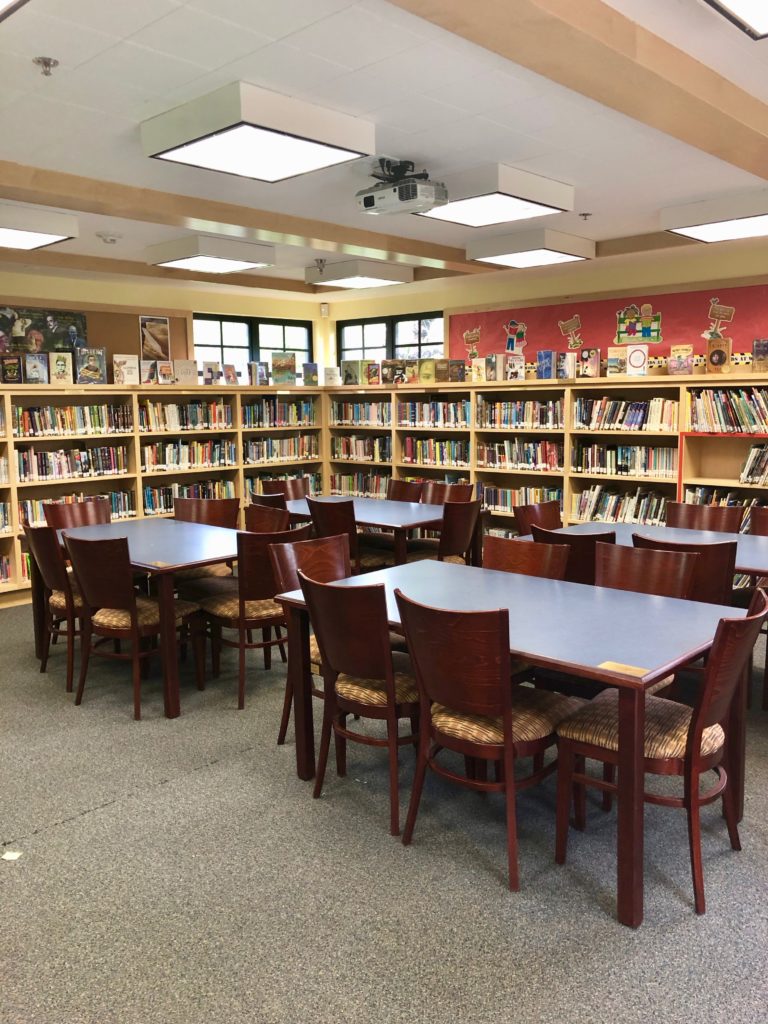
Q: Gooden students and faculty have served over 38 nonprofit agencies and middle schoolers perform an average of 1,732 service hours each year. That’s a lot! How is community service integrated into the curriculum?
A: The Gooden School’s mission encourages students, faculty and staff to be responsible for their communities, their sustenance and improvement. This includes the community of our families, of our school, and of all the other communities of which we are a part. As part of the curriculum, students are required to report on and reflect about their community engagement experiences. Whether they are crocheting scarves for the homeless or collecting eggs from our on-campus chickens for a food bank, or working with the local Humane Society, all of these experiences deepen their connection to the curriculum, each other, and the world.
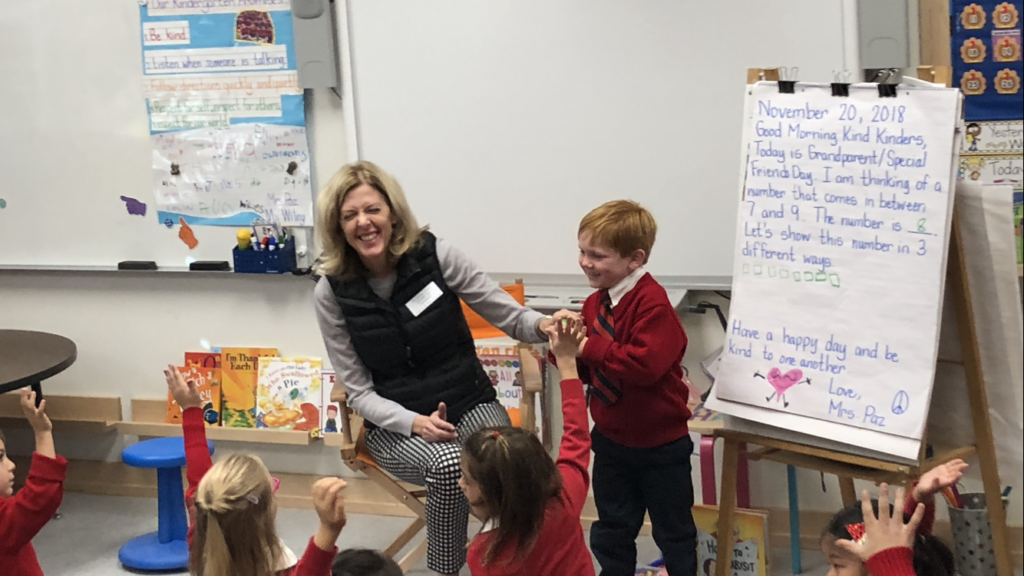
Q: What schools do Gooden 8thgrade students attend after graduation?
A: Gooden students matriculate to a wide variety of independent, private, and high performing public schools in the Los Angeles and San Gabriel Valley areas. Under the guidance of Gooden’s head of school, students and their families select high schools that will continue to nurture their gifts and grow further as problem solvers, advocates, and leaders.
This year Gooden students were accepted to the following high schools: Alverno Heights Academy, Campbell Hall, Damien High School, Flintridge Preparatory School, Flintridge Sacred Heart Academy, Harvard-Westlake School, Immaculate Heart High School, La Salle High School, Loyola High School of Los Angeles, Maranatha High School, Marshall Fundamental School, Mayfield Senior School, Notre Dame High School, Orange County School of the Arts, Polytechnic School, Providence High School, Sequoyah High School, St. Francis High School, Waverly School, The Webb Schools, and Westridge School for Girls.
For more information, visit www.goodenschool.org 192 Baldwin Ave. Sierra Madre, CA 91024. Note: The school is very close to Pasadena.
Stay up to date on the latest L.A. private schools news and events! Follow Beyond The Brochure on Facebook. Buy the book on Amazon.

Applying to Private Middle and High School in Los Angeles
Yes, it’s already that time! Some schools have their fall open houses scheduled already or will soon. Ditto with other events, such as the increasing number of parent coffees hosted by current families at the different schools.
If you are considering the private school option for middle or high school, the most important piece of applying to private school is to put together a plan to see what’s out there, narrow down your list, and get through the multi-faceted application process. This is definitely a process, and not just a one-time effort.
A private school application is a process with many moving parts. Some of these elements are in your control – touring schools, filling out the applications, meeting application deadlines, interviewing with admissions staff – while some definitely are not – teacher recommendations, for example, or how your student does on the entrance exam, or in the interview or assessment. People can find this process both time-consuming and nerve-wracking. The reason is simple; this is a complex process, and private schools are selective and can choose the students they accept into the school.
While it might be time-consuming, you should read through the websites for each of the schools you’re interested in. The school open house and tour will give you a better feel for the school and the families that attend that school; the websites go into great detail about the curriculum and philosophy of each school. But let’s take a look at the steps in the private school selection process, to help you get a better overview of what’s involved. Applying to private school is the same for every school and includes:
1. Identifying schools – in putting together your initial list of schools, do take your child’s advisor or academic dean’s recommendations into account. But it’s important to keep an open mind and tour a variety of schools, not just the one or two that everyone’s heard of. Your sister’s hairdresser’s nephew might be doing great at a particular school, but that bears no relation to how your child might fare at the same school. You are looking for your student – not for other learners, and definitely not for yourself. Tour as many schools as possible, and then narrow down your list. Plan to apply to at least four schools.
2. Attending tours and/or Open Houses – this is mandatory. There is a separate tour/open house for middle and high school students. Open Houses generally take place nights and weekends, while tours are usually during the school day. Some schools will allow you to do both.
3. Completing applications – most of these are online these days and there is a parent section and a student section. School applications may have anywhere from 3-10 questions about your child, their school experience so far, your family’s expectations about school, and how you have participated in your child’s current school. For the student you can expect a number of questions requiring one word or one sentence answers, as well as an essay – or two or three – with a writing prompt. This must be completed by the student, not the parent, and definitely not a hired hand! In addition to a school’s main application questionnaire, you will have to provide:
4. Parent Interview – once you have submitted an application, the school will schedule your interview. Unless you’re out of town on the date you’re assigned, you should make every effort to make the assigned interview date. You want the school to feel like it will be easy to work with you! Please be aware, though, that for middle and high school many schools do not interview the parents at all.
5. Student assessment – there are two types of student assessments required for middle and high school students: the ISEE (Independent School Entrance Exam), the SSAT (Secondary School Admissions Test, used for some L.A. schools and boarding schools nation-wide) or the HSPT (High School Placement Test for Catholic schools); and the student interview. Once you have submitted an application, the school will schedule the student interview. This may be an individual or group interview.
From 5th grade and up, most incoming students applying to private schools must take the ISEE – the Independent School Entrance Exam. At least one school requires the ISEE for 4th grade applicants. Check with the requirement of each particular school, and be aware that the test must be taken, with results sent to the schools you’re applying to, prior to the last acceptable testing date for each school. These are challenging exams; for most students, prep is advisable. If your student requires special accommodations, like extra time, be prepared to provide documentation supporting that need.
6. Student shadow day – some schools allow students to spend a shadow day at the school, whether that is individually organized – attending specific classes and activities – or for a group of students on a certain day. It is certainly worth taking part if offered – this is a great way for the student to get more of an inside look at the school.
Los Angeles is a very large city, with a limited number of private schools. Added to this is the unhappy fact that siblings, legacies and school personnel get preference in admissions. The only way for you to affect how a school views your child and your family is to apply to schools that are really the best possible fit.
I can’t stress this enough – the most important factor in applying to private schools is making sure that you’re applying to schools that are the right fit for your child. That means taking your wish list out of the equation, to some extent. Is this the right school for them? All schools should provide intellectual challenges, but there is a difference between a challenge and a struggle. Knowing who your child is as a student is key. So yes, tour a variety of schools, by all means. But also make sure that you’re not just considering a school because it fits you. It really needs to be a fit for them.
Thoroughly overwhelmed about the school selection and application process Kindergarten through college? I am now scheduling consultations for September 2020 admissions. Please contact Sandy Eiges at www.laschoolscout.com for Kindergarten-College, or call me directly at 310 926 0050.
Stay up to date on the latest L.A. private schools news and events! Follow Beyond The Brochure on Facebook. Buy the book on Amazon.
I recently stopped by the Independent School Alliance for Minority Affairs (Alliance) to meet with executive director Robert Evans. I’ve been a longtime admirer of the work the Alliance does to help families of color navigate the competitive independent school (also commonly called private school) admissions process. In person, Robert is a wealth of information about school admissions. As a former independent school educator and current parent at a top school, Robert is a true insider who understands how school admissions really work. He also happens to be a very smart, friendly and outgoing guy who welcomes families to his office where, along with his staff, they roll up their sleeves and tackle all aspects of admissions. The goal? Acceptance to schools like Buckley, Brentwood, Campbell Hall, The Center For Early Education, Crossroads, Harvard-Westlake, John Thomas Dye, Polytechnic, Viewpoint, Walden and Westland to name a few. The admissions success rate for Alliance families speaks for itself: 84 percent of families are accepted to schools where they apply (the average acceptance rate for non-Alliance families is around 20 percent). The deadline to apply to work with the Alliance is August 1, 2019. Thank you Robert for your time and the work you do! –Christina
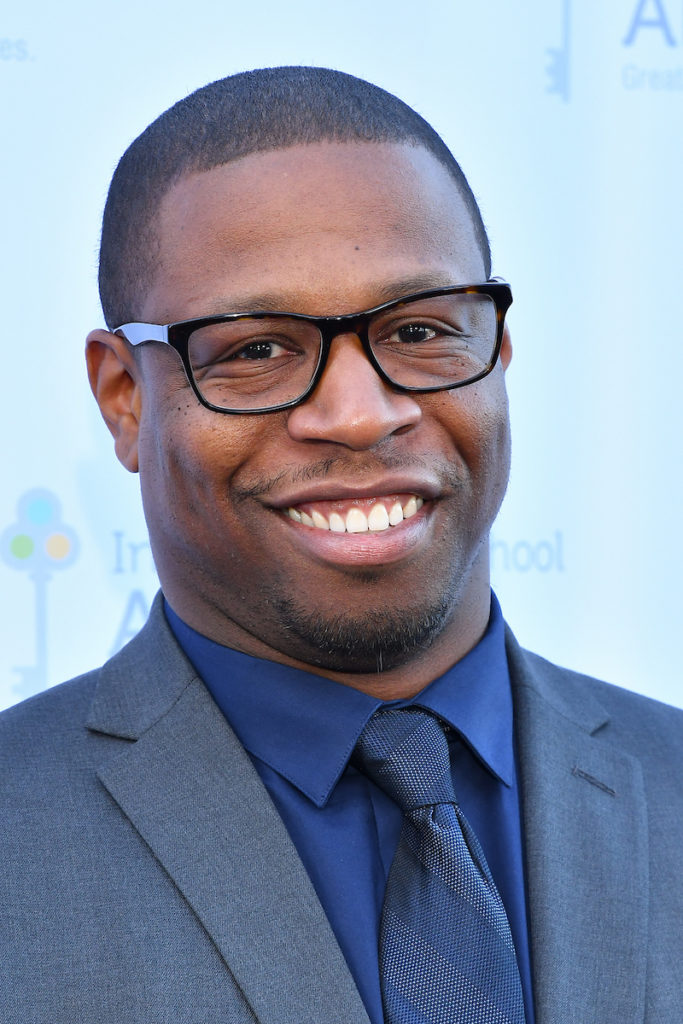
Q: How does the Independent School Alliance for Minority Affairs (Alliance) help families get into the most competitive private schools in Los Angeles and the San Gabriel Valley?
A: We understand that choosing the right school is by far one of the most important decisions that parents can make for their child. For 35 years, we have worked with our families to demystify the complexity of applying to independent schools. Our program takes a holistic approach to school admissions by providing general education about the various schooling options offered at our 50+ member schools; leading families through the application process; providing testing preparation services for students; matching families to schools that best meet their needs; and providing ongoing support for students in families throughout their educational career.
We offer workshops and resources on educational philosophies so that our parents understand the mission and vision of our 50+ unique member schools. Through our program, parents learn about progressive, developmental, project-based, constructivist, and traditional approaches to education. As parents consider the various schooling options, we perform an initial vetting in order to understand the best fit for their child’s strengths, personality, and learning style. When our member schools receive an application from the Alliance, they know and trust that we have worked hard to ensure a good match for all parties involved. Additionally, we take the stress out of the paperwork of applying as Alliance families complete ONE common application, which is honored by all of our member schools. We also offer fee waivers for the ISEE, FAST, and SSS, which make the cost of applying to independent school substantially lower than families who apply without the support of the Alliance.
Q: Do families have to demonstrate financial need to work with the Alliance? Also, do you assist families with the financial process at private schools?
A: The Alliance brokers substantial financial aid for an average of 80% of its students annually. We provide information regarding budgeting and financial planning for independent school education, and we work with our families to identify schools that are within the financial range of what they are able and willing to contribute. We are very proud to work with families of varying degrees of socioeconomic status as many of our families are considered low-to-moderate income while others are able to pay 50% to 90% of their tuition fees.
Tuition and fees vary according to the type of school (day school, boarding, etc.) and other factors. Although independent schools rely on tuition income as their major source of revenue, financial aid may be available to families who qualify. Details about financial aid policies and how to apply for financial assistance can be obtained from the individual schools.
Q: What percentage of Alliance families are accepted to schools where they apply?
A: Approximately 84% of the students who apply through the Independent School Alliance are accepted at one or more of our 50+ member schools. Such a high percentage rate of acceptance can be credited to personal counseling, appropriate recommendations, and solid matches between families and schools by the Independent School Alliance staff.
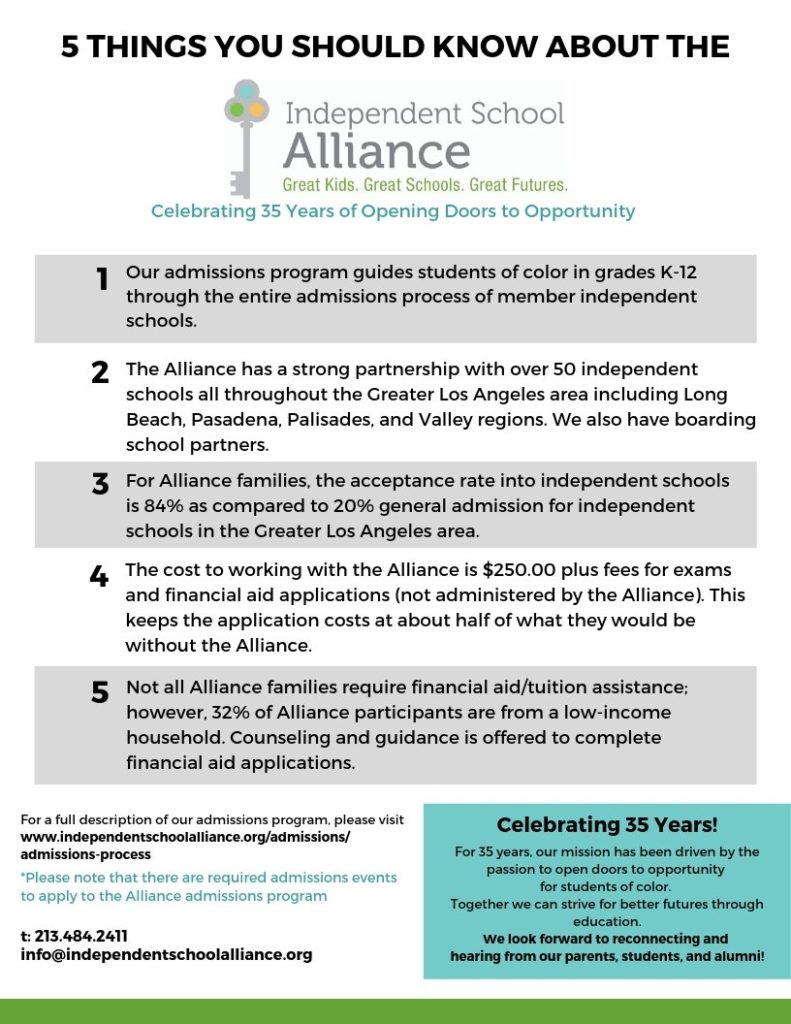
Q: How does your experience as an educator help the Alliance’s families find the right school?
A: I am fortunate to come into the role of Executive Director of the Alliance having previously taught in one of our member schools and having two of my children in another. As a parent, I understand the importance of community and believe in the culture of academic excellence that is supported at independent schools. I empathize with other parents with wanting my children to have educational success in an environment that nurtures their abilities, grows their interest, and helps to define their talents. As an educator, I also understand that students thrive in an environment that is built upon the foundation of relationships, respect, and rigor; and it is therefore important for a school to employ teachers who are committed to educating the whole child with love, care, and respect. As such, I have chosen to educate my children in the independent school environment and speak from firsthand knowledge about our experience in this community as a family.
Additionally, I am on the board of an organization that focuses on diversity, equity, and inclusion efforts in Southern California independent schools. This organization works in tandem with the support prong of the Alliance’s mission to provide resources, professional development, and opportunities for conversations, programming, and institutional changes to make our schools more equitable. My experiences as both a parent of children in independent schools and as an independent school educator has definitely informed my understanding of how best to serve Alliance families as they prepare to join the independent school community.
Q: The Alliance’s board of directors includes administrators from Archer, Crossroads, Harvard-Westlake and Wildwood. The board members serve terms, but you have a direct line to officials at highly selective schools every year. How do you use this access on behalf of ISA families?
A: We were fortunate to have independent school educators involved at the inception of the founding of our organization. Our governance committee of the board has determined that a quarter of our board must be comprised of senior administrators from our member schools at all times. This intentionality allows us to keep our fingers on the pulse of issues that affect independent schools. Additionally, each year we meet with our partners about their specific needs as a school and ensure that we are in communication about the changing landscape of admissions in independent schools. We engage in ongoing work with our member schools throughout each school year to increase diversity on their campuses while simultaneously working to eliminate inequitable barriers to educational access.
In thinking about how to best utilize our unique access to member schools, we have adopted a philosophy of family and student advocacy. Through mutual respect, communication, and understanding, we gain a commitment from our school partners to help our students and families gain access to a great education. Throughout the admissions process, we have frequent touchpoints with our member schools to ensure that our students and families have the most opportune chance of being considered for admission. Our strategic advocacy, intentional programming, and well-designed and organized support systems influence school decision makers about all the important issues that will affect the student, family, and school community.
Q: Is there a student who stands out in your mind as a great example of the partnership between the Alliance and a family?
A: Partnerships ensure that students are active participants in the learning process and parents are well- informed about their child’s educational experiences. Strong partnerships are built on regular, open communication about educational goals, as well as student academic achievement and personal development. These relationships are an integral part of quality education.
Parents play an essential and positive role in the life of an independent school and in the life of the Alliance as an organization. Not only are parents advocates for their children, but they also support the school and the Alliance through extensive volunteer activities and events.
There are a number of students that stand out as great examples of the partnership between families and the Alliance. One such example is found in the partnership between the Alliance and Kelsey and her mom, Roberta (both pseudonyms). Kelsey and her mom used our program twice for middle and again for high school. Kelsey was a reserved and soft-spoken student when she initially applied to our program; however, today, Kelsey is one of the Alliance’s biggest cheerleaders and she also serves as a Youth Ambassador. Kelsey supports us by attending our information sessions for outreach in the community and providing prospective Alliance families with anecdotes about her personal independent school experience. Her mom, Roberta, routinely volunteers to support the Alliance. She was most recently a greeter at our annual family end-of-school-year gathering. Whenever we ask, Roberta is there to offer the support and feedback that we need to improve our ability to meet the needs of our families and students. We truly appreciate the commitment and dedication of families such as Kelsey and Roberta and we are grateful for their ongoing support and family advocacy. We look forward to seeing how Kelsey continues to learn and grow during her educational career.
One success story that comes to mind is of Kalief (also a pseudonym), a young man who entered our program in the 6th grade. After graduating from a member school and an Ivy League college, Kalief returned to the Los Angeles area to serve as a teacher in one of our partner schools. In addition, Kalief also made his way back to the Alliance to support our mission as a teacher in our Student Orientation Program, which is designed as a transition program for new students. Last summer, when I walked into Kalief’s classroom, his students were reading the Declaration of Independence, the Ten-Point Plan of the Black Panther Party, and the Brown Beret Ten-Point Program. Kalief not only challenged his students to think through primary source documents for contextual understanding but to also extract information from these documents to make informed judgments related to decisions of the time. It was amazing to watch 6th graders grapple with issues of justice while simultaneously strengthening their reading and comprehension skills. Kalief used narrative comments, report cards, and test scores of our students to create personalized, needs-based, skills-based, and culturally competent class lessons. I sincerely appreciated the care and energy that he put into this learning experience and believe that his personal connection to the Alliance made the experience much more fruitful for our students.
For more information, contact the Independent School Alliance for Minority Affairs. The deadline to work with the Alliance is August 1, 2019! Information sessions will be held July 20 and August 1. 2019.
Stay up to date on the latest L.A. private schools news and events! Follow Beyond The Brochure on Facebook. Buy the book on Amazon.